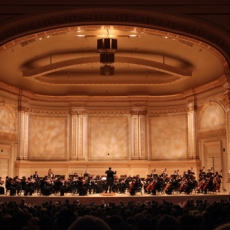The Orchestra of the Americas - Pan-American Reflections - All Music
4.5*
The Orchestra of the Americas, based in Mexico City and taking inspiration and support from both North and South America, is made up of young musicians and forms something of a counterpart to youth-oriented European groups. This release, issued by Scotland's Linn label, ought to expand their reputation. The program draws attention in itself. It would have been very easy to feature works containing Latin rhythms in this album, Pan-American Reflections, inasmuch as Aaron Copland drew major inspiration from such rhythms in the ballet Rodeo and other works, and probably learned some of them from the other composer on the bill, Mexico's Carlos Chávez. Instead, conductor Carlos Miguel Prieto takes a less obvious tack. The Copland Symphony No. 3 is notable as the work from his populist period that uses the least popular influences, and there's hardly a trace of Latin sound. Chávez for his part, in the Symphony No. 2 ("Sinfonía India"), draws not from Latin American rhythms, but from Native American music, with several non-Western instruments among his percussion battery. And it turns out that the kinship between the two composers, which involved a personal friendship along with musical factors, does not depend merely on the use of Latin rhythms. Chávez used a Copland-like idiom involving lots of brass and widely spaced intervals of a fourth or fifth, in some cases before Copland did, and the two composers favored an epic, broadly appealing style that nevertheless did not reject modernist influences. The Orchestra of the Americas handles the crucial brass writing of both composers well, and the players are unfazed by the colorful details of Copland's orchestration (sample the slow movement of the symphony, especially at the end). It's a superior Copland 3, whether you chalk it up to youthful enthusiasm or some other factor. The music of the Latin American symphonists is still underexposed, but Linn here demonstrates some of the riches that are recoverable in this vein. The label also deserves credit for its use of Diego Rivera's "Detroit Industry" mural in the graphics; it's another work that reflects Latin American-North American interactions in something other than the usual way. Highly recommended.


